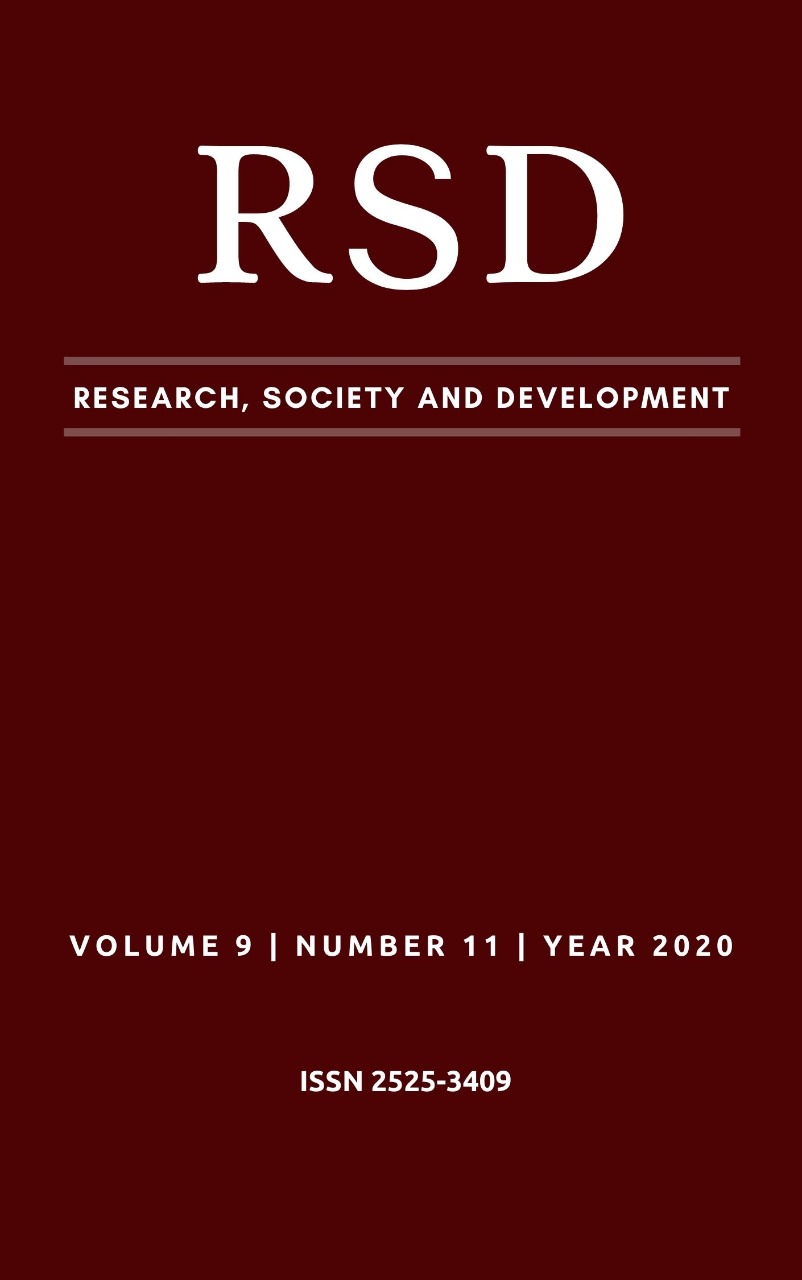Determination of adsortive capacity (Ca) of granulated activated carbon (Cag) used in chemical filters for the retention of organic vapors
DOI:
https://doi.org/10.33448/rsd-v9i11.9662Keywords:
Granulated activated carbono, Adsorption, Chemical flters, Organic solvent.Abstract
Granulated activated carbon (CAG) is widely used in filters of chemical respiratory devices to retain organic solvents, acid gases, ammonia and hydrogen sulfide. Its use is due to its high area / mass ratio, which gives it a large surface of adsorption of gaseous contaminants, which can vary between 300 and 1,300 m2g-1 depending on the raw material used in its manufacture, chemical treatment. and dimensions. The objective of this work was to develop a methodology using an experimental arrangement consisting of a circuit to cause saturation of a semifacial respiratory filter (SF) using a organic solvente and this way measure the adsorptive capacity (Ca) of the CAG. Under assay conditions, with toluene as solvent, the Ca value obtained was 110.2 mg.g-1. The model presented provided a useful parameter for manufacturers and useers as an indicator for quality control of chemical filters used in semifacial respiratory devices, allowing the comparison between batches of GACs originated from different raw materials, shapes and dimensions.
References
ABNT (2017): Associação Brasileira de Normas Técnicas. NBR 12.543: Equipamentos de Proteção Respiratória- Terminologia. Rio de Janeiro: ABNT.
Atikins, P. W. (1986). Fisico Quimica. (3a ed.), Version em español de Bárbara Loeb Luschow (Universidade Católica de Chile) y Miguel Angel Rios Fernandez (Universidad de Santiago de Compostela, España). Addison-Wesley Iberoamericana S. A, Wilmington, Delawere, EUA..
ANP (2001). Agência Nacional do Petróleo, Gás Natural e Biocombustíveis. Anuário Estatístico Brasileiro Do Petróleo, Gás Natural E Biocombustíveis. Rio de Janeiro: ANP.
ATSDR (2004). U.S. Department of Health and Human Services. Interaction profile for: Benzene, Toluene, Ethylbenzene, and Xylenes (BTEX). Atlanta, GA: Agency for Toxic Substances and Disease Registry (ATSDR).
Brevigliero, E., Possebon, J. & Spinelli, R. (2006). Higiene Ocupacional. Agentes Biológicos, Químicos e Físicos. SENAC. 320p.
Brinques, G. B (2005). Adsorção de Tolueno de Solução Aquosa em Leito de Carvão Ativado em Planta Piloto. Universidade Federal do Rio Grande do Sul. Escola de Engenharia. Departamento de Engenharia Química. Programa de Pós-Graduação em Engenharia Química. Dissertação de Mestrado. Porto Alegre.
CCC (2017). Calgon Carbon Corporation. Ganular Activated Carbon for Respirators. Recuperado de http://www.calgoncarbon.com/media/press-releases/2017-06-11/calgon-carbon-announces-third-quarter-2017-results/>.
Faulconer, E. K. (2012). Effects of activated carbon surface chemistry modification on the adsorption of mercury from aqueous solution. University of Florida.
Fogler, H. S. (1998). Elements of Chemical Reaction Engineering. (3a ed.), Prentice- Hall.
László, K., podloscielny, P., & Dabrowski, A. (2005). Heterogeneity of activated carbons with diferente surface chemistry in adsorption of phenol from aqueous solutions. Applied Surface Science.252, 5752-5762.
Lilo-Ródenas, M. A., Fletcher, A. J., Thomas, K. M., Cazorla-Amorós, D., & Linares-Solano, A. (2006). Competitive adsorption of benzene-toluene mixture on actvated carbons at low concentration. Carbon. 44(1), 455-1463.
Pereira, A. S., et al. (2018). Metodologia da pesquisa científica. [e-book].Santa Maria. Ed. UAB/NTE/UFSM. Recuperado de https://repositorio.ufsm.br/bitstream/handle/1/15824/Lic_ Computacao_Metodologia-Pesquisa-Cientifica.pdf?sequence=1.
Ruthven, D. M. (1984). Principles of Adsorption and Adsorption Processes. John Wiley Sons, Inc., Canada.
Torloni, M., & Vieira, A. V.(2003) Manual de Proteção Respiratória. (2a ed.), São Paulo: Editora Abho.
Downloads
Published
Issue
Section
License
Copyright (c) 2020 Silvia Pierre Irazusta; Cleber Corrêa Vieira; Francisco Tadeu Degasperi; Fabricio José Piacente

This work is licensed under a Creative Commons Attribution 4.0 International License.
Authors who publish with this journal agree to the following terms:
1) Authors retain copyright and grant the journal right of first publication with the work simultaneously licensed under a Creative Commons Attribution License that allows others to share the work with an acknowledgement of the work's authorship and initial publication in this journal.
2) Authors are able to enter into separate, additional contractual arrangements for the non-exclusive distribution of the journal's published version of the work (e.g., post it to an institutional repository or publish it in a book), with an acknowledgement of its initial publication in this journal.
3) Authors are permitted and encouraged to post their work online (e.g., in institutional repositories or on their website) prior to and during the submission process, as it can lead to productive exchanges, as well as earlier and greater citation of published work.


